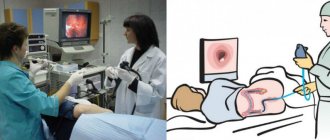Classification of gastritis
Gastritis can be acute or chronic. Both diseases differ in duration, course, causes and symptoms. In addition, acute gastritis can be cured, but it is impossible to get rid of chronic gastritis; with the help of nutritional correction and treatment, you can only achieve stable remission (temporary weakening or complete disappearance of symptoms).
Acute gastritis is an acute inflammation of the gastric mucosa that occurs due to exposure to a strong irritant that enters the stomach cavity.
Chronic gastritis is a disease characterized by chronic inflammation of the gastric mucosa with the gradual development of atrophy (reduction in the size and weight of an organ or tissue with weakening or complete cessation of their activity) of the gastric glands, which leads to a deterioration in the functions of the stomach. It is often accompanied by duodenitis - inflammation of the duodenal mucosa. The combination of gastritis and duodenitis is called gastroduodenitis.
Chronic gastritis has its own classifications, so it is worth talking about it separately.
Chronic gastritis
According to the causes of chronic gastritis, there are:
- Primary (exogenous). As an independent disease.
- Secondary (endogenous). As one of the manifestations of other somatic pathologies.
By localization:
- Focal (fundal). When it affects the bottom of the stomach;
- Common. Affects several sections, most or all of the stomach (pangastritis);
- Combined (gastroduodenitis). It causes inflammation of the stomach and duodenum.
With the flow:
- Latent (hidden, asymptomatic);
- Monotonous (symptoms are always present);
- Recurrent (alternate periods of exacerbations and remissions).
By stages (phases) of the process:
- Exacerbation (severe symptoms);
- Incomplete clinical remission (unexpressed symptoms, inflammation of the stomach is visible during FGDS);
- Clinical remission (there are no symptoms, but during FGDS inflammation of the mucous membrane is detected);
- Clinical and endoscopic remission (no symptoms, no traces of inflammation during instrumental examination).
According to changes in the mucous membrane:
- Superficial (without atrophy);
- Hypertrophic (with the growth of the mucous membrane, the formation of cysts and polyps);
- Hemorrhagic (tendency to bleeding from the walls of the stomach);
- Erosive (with the formation of stomach ulcers);
- Subatrophic (slow small-focal atrophy);
- Atrophic;
- Mixed.
Development mechanisms
Causes of acute gastritis in children:
- Foodborne illness (a gastrointestinal disease that occurs after eating food containing bacteria and their toxins. Often occurs due to the consumption of rotten foods, unwashed fruits or dirty water);
- Long-term use of certain medications (salicylates, sulfonamides, glucocorticoids, digitalis preparations, etc.);
- Poisoning with household poisons;
- Allergy.
When a large number of bacteria enter the gastrointestinal tract, inflammation occurs. Excess fatty, spicy and poorly chewed food slows down the evacuation (removal) of stomach contents and worsens the secretory function of the organ (the secretion of digestive juice for digesting food). The food lump lingers in the stomach, it is saturated with enzymes, after which it disintegrates due to the action of bacteria, and the fermentation process begins.
Which leads to aggravation of the course and chronicity of the process.
Causes of chronic gastritis in children:
- The presence of the bacterial flora Helicobacter pylori (the same bacterium leads to ulcers). In 80-85% of cases it is what causes gastritis;
- Poor nutrition (eating rough, too hot or cold, fatty, spicy or poorly chewed food);
- Dry food;
- Eating 1-2 times a day or less often;
- Lack of vitamins, complete proteins and fats in the diet;
- Endocrine diseases;
- Kidney damage;
- Diseases of the cardiovascular system;
- Long-term use of medications (salicylates, sulfonamides);
- The source of infection in the oral cavity (disease of teeth and gums);
- Burdened heredity;
- Allergies.
The factors that cause acute and chronic gastritis are similar or even coincide. The main difference is the duration of their effect on the body. In acute gastritis, one contact with an irritant (expired cottage cheese or a large portion of fast food) is enough for an attack. In chronic gastritis, an irritating factor acts on the gastric mucosa for a long time and repeatedly, gradually leading to a decrease in the activity of the digestive glands.
Algorithm for examination and treatment of young children with constipation
For citation. Komarova O.N., Khavkin A.I. Algorithm for examination and treatment of young children with constipation // RMZh. 2016. No. 6. pp. 358–360.
According to statistics, in pediatric gastroenterological practice, constipation is the most common reason for visiting a doctor and accounts for 25 to 40% of all cases, while about half of the observed patients are young children.
Children who are bottle-fed most often suffer from constipation [1]. How to diagnose constipation? Most often, parents go to the doctor with complaints
of rare and/or painful and/or difficult bowel movements in children.
Indeed, the diagnosis of “constipation” in the first year of a child’s life is completely clinical and is established on the basis of anamnesis and complaints from the patient’s parents. The main criteria for diagnosing constipation are rare, painful, difficult bowel movements or incomplete bowel movements that occur within 2 weeks. and more, which are significant causes of impairment of the child’s health [2]. First, let’s decide on the “norms” for stool frequency. In infants who are exclusively breastfed, the frequency of stool can vary from the usual - after each feeding - to once every 3-4 weeks. Rare bowel movements (oligofecalia) in newborns are associated with more complete absorption of food. This condition is interpreted as “pseudoconstipation”. In this case, the nature of the stool has a pasty or liquid consistency, and only in 1.1% of cases is dense stool observed [3]. Most authors believe that in this situation, in the absence of regurgitation, vomiting, abdominal wall tension or other gastrointestinal symptoms, and the child’s normal weight gain, correction is not required. As a rule, the frequency of bowel movements increases with the introduction of complementary foods. But our opinion: it is necessary to carry out corrective measures in order to achieve bowel movement at least once every 2-3 days. The frequency of stool in a bottle-fed child should be at least 1 time per day, and with the introduction of complementary foods at 4–6 months. a frequency of 1–2 times a day is considered normal. Reduced bowel movements are interpreted as constipation. anamnesis
is important in identifying the causes of constipation .
In a conversation with parents, it is necessary to find out when constipation began and what events preceded it. For example, the formation of constipation due to dehydration of feces is typical for acute febrile conditions against the background of febrile temperature and severe sweating, as well as after an intestinal infection, such as dysentery. When prescribing drug therapy with drugs such as antispasmodics, anticholinergics, calcium channel blockers, muscle relaxants, anticonvulsants, iron supplements, a decrease in stool frequency is observed. A common cause of constipation in infants
is underfeeding.
Insufficient milk consumption is observed more often during breastfeeding. Malnutrition may be associated, firstly, with hypogalactia in the mother, and secondly, for example, in children with abnormalities of the facial skeleton, with defects in the oral cavity or with general weakness of the child. Also the cause of underfeeding is persistent regurgitation and vomiting. In addition, children with infantile anorexia or nutritional underdevelopment also often experience constipation. The formation of these conditions is based on violations of the mother-child relationship, when mothers have little interest in their children and do not ensure that they receive the required amount of nutrition during feeding. Malnutrition can be diagnosed in a child by scanty, viscous consistency and dark-colored stool, as well as oliguria and malnutrition, which develop due to insufficient intake of fluids and nutrients. In such a situation, it is important to assess the general condition of the child, the degree of dehydration and malnutrition and make corrections. Constipation is observed in children when changing their diet: when switching from breastfeeding to artificial feeding, as well as when introducing complementary foods. Constipation is caused by inadequate, excessive intake of calcium salts from food, for example, from cottage cheese consumed in larger quantities than recommended. Calcium soaps formed in the intestine are not absorbed and cause hard stools. A similar situation is also observed with excess vitamin D. It is important to clarify the presence of a disease accompanying constipation for correct and timely correction. Thus, constipation often occurs in patients with food allergies. In particular, the relationship between allergy to cow's milk proteins and constipation has been proven [4]. Constipation develops due to the occurrence of local areas of spasm and swelling in the intestine as a result of the production of inflammatory mediators under the influence of an allergen. In 10% of children, lactase deficiency occurs with constipation due to intestinal spasm caused by the acidic pH of the contents of the colon. The cause of constipation can be muscle hypotension - a symptom of various diseases diagnosed in early childhood, primarily rickets or hypothyroidism, and less often L-carnitine deficiency. The main symptoms of L-carnitine deficiency, in addition to muscle hypotonia and constipation, are regurgitation and delayed physical development [5]. In the presence of a persistent progressive nature of constipation and the absence of independent defecation, with an enlarged abdomen, palpable fecal stones, a lag in the rate of physical development, it is necessary to exclude organic pathology: • congenital anomalies of the colon (for example, Hirschsprung's disease, dolichocolon, dolichosigma, duplication of the colon, megacolon, mobile cecum, mobile sigma, splanchnoptosis); • congenital anomalies of the rectum and anus (fistulous forms of anal atresia, congenital strictures of the anus and rectum); • neuromuscular disorders (hypogangliosis, inflammatory neuropathy and degenerative leiomyopathy); • mechanical obstruction in the intestine (inflammatory adhesions, tumors, enlarged lymph nodes) [6]. When analyzing complaints, it is important to clarify how long after birth the passage of meconium was observed. Delayed passage of meconium more than 48 hours after birth may indicate Hirschsprung's disease or cystic fibrosis. To confirm Hirschsprung's disease, it is enough to perform irrigography in the direct and lateral projections. The images usually clearly show a zone of persistent narrowing in the distal part of the colon (zone of aganglionosis) with expansion and impaired emptying of its more proximal parts. In addition, the diagnosis is confirmed after studying a transmural biopsy taken surgically from the intestine. The absence of nerve ganglia in the biopsy specimen, as well as a high level of acetylcholinesterase, confirms the diagnosis of Hirschsprung disease, which requires surgical treatment [7]. It is important to note that in 90–95% of cases there is no organic cause of constipation in a child. The most common constipation is of a functional nature, which develops in young children due to the immaturity of central and peripheral neuroregulation, leading to disruption of the motor and secretory functions of the gastrointestinal tract (GIT). The immaturity of neuromuscular transmission is due to weak myelination of nerve trunks and insufficiency of transmitters in interneuron and neuromuscular synapses. For a more reasonable diagnosis, one should rely on the Rome III criteria, according to which constipation can be a manifestation of the following types of functional disorders: difficulty defecating in newborns (dyschezia - G6) and functional constipation in children from birth to 4 years of age (G7) [8] . In the presence of difficult defecation, accompanied by severe straining, groaning and crying, one should suspect infantile dyschezia, the formation of which is based on the immaturity of the lumbosacral nerve plexus pathways, as well as the child’s inability to coordinately strain the abdominal muscles and simultaneously relax the pelvic floor muscles. The process of defecation gives the child anxiety; the stool is soft; after defecation, the child usually calms down. Dyschezia is observed from the 1st to the 10th week of a child’s life. Quite often in pediatric practice there are situations when the frequency of stool corresponds to the norm, but the stool is dense, fragmented, in scanty quantities, parents describe it as “sheep” feces. These are signs of incomplete bowel movement and, accordingly, constipation. The presence of blood on the surface of the stool indicates irritation of the intestine or anal fissure in the child, which, as a rule, is a consequence of injury to the intestinal mucosa by dense feces. Thus, when collecting complaints and anamnesis, it is necessary to find out the frequency and nature of bowel movements, duration of constipation, method of feeding, allergy history, and collect information about concomitant pathologies and medications taken. When examining
a child, one should evaluate weight and height indicators, the position of the anus, the anal reflex, pay attention to an enlarged abdomen, detect feces in the intestines during palpation, and conduct a digital rectal examination.
The presence of pigmentation, hair growth in the lumbosacral region, depression in the sacral spine, dystopia of the anus, abnormalities of the gluteal cleft, and absence of the anal reflex indicate the need to exclude an organic cause of constipation. Additional studies
are being conducted to clarify the cause of constipation.
A clinical analysis of blood, urine, coprogram, stool analysis for worm eggs, and ultrasound of the abdominal organs are performed. According to indications, general radiography of the gastrointestinal tract, irrigoscopy, radiography and/or MRI examination of the lumbosacral spine (clarification of malformations of the spinal cord), sigmoidoscopy, colonoscopy, allergy examination, hormonal profile study (thyroid hormones), electroencephalography, exclusion study are prescribed disaccharidase deficiency, celiac disease (suspicion arises only when the child receives gluten-containing foods). If necessary, consultations are held with medical specialists: neurologist, endocrinologist, surgeon, geneticist. It should be noted that accumulated clinical experience usually allows only a well-collected history and a thorough examination of the child to exclude an organic cause of constipation. There is no need to carry out a complex set of examinations and laboratory tests before starting treatment. Only in cases with alarming clinical symptoms or in the absence of improvement against the background of traditional therapy, further studies are indicated. Alarming symptoms that require clarification of surgical, infectious pathology, inflammatory bowel diseases are: unmotivated loss of body weight, rise in temperature, vomiting of bile, the appearance of blood in the stool (in the absence of anal fissures), muscle tension of the anterior abdominal wall and pain on palpation, changes in clinical blood test (anemia, leukocytosis, increased ESR) and biochemical blood test. The goal of treating
constipation in children is to restore the normal consistency of intestinal contents and its passage through the colon.
To correct constipation, an integrated approach is used with dietary therapy, and, if necessary, drug therapy and mechanical bowel movement. When a concomitant disease is identified, its correct correction is important, which will help resolve constipation (for example, in the presence of rickets, an adequate dose of vitamin D is selected, etc.). The main way to correct constipation in early childhood is diet therapy
. The main and important rule is to maintain breastfeeding for as long as possible. In breastfed children, the composition of mother's milk should be adjusted, which in many cases is achieved by optimizing the mother's diet. In particular, it is known that the fat composition of breast milk and the mother's diet are identical. Therefore, it is advisable to include in the diet of mothers vegetable oils that stimulate intestinal motility, as well as foods high in dietary fiber (vegetables, fruits, cereals, wholemeal bread, etc.) [9]. If a breastfed child has an allergy to cow's milk proteins, the nursing mother is prescribed a hypoallergenic diet excluding milk and dairy products, and the bottle-fed child is prescribed specialized semi-elemental or elemental mixtures (based on complete hydrolyzed protein and amino acids, respectively). For a formula-fed baby, the formula is selected individually, since it is important to collectively evaluate the clinical symptoms. For example, when constipation and regurgitation are combined, it is recommended to prescribe mixtures containing carob gluten, which increase the viscosity of the mixtures and have an anti-reflux and laxative effect [9]. In patients with constipation, mixtures containing a modified fat component have worked well: supplemented with beta palmitate or without palm oil as the main source of fat in the oil mixture. It is known that approximately 70% of palmitic acid in breast milk is associated with the central carbon atom in the glycerol molecule, i.e., it is located in the sn-2 position, whereas in standard mixtures palmitic acid is located mainly in the edge positions - sn-1 and sn- 3 [10]. Differences in the position of palmitic acid on the triglyceride molecule in breast milk and vegetable oils are a major factor responsible for differences in the digestion and absorption of some ingredients in breast milk and infant formula. The ester bonds connecting palmitic acid to the backbone of the glycerol molecule at the edge positions are easily hydrolyzed by pancreatic lipase in the intestine. The released palmitic acid forms insoluble complexes with calcium in infant formula - calcium soaps, which are not absorbed in the intestine, but are excreted in the stool, changing its characteristics: the stool becomes denser and bowel movements occur with less frequency. In addition, along with insoluble calcium soaps, the body loses calcium and an important energy donor - palmitic acid. The exact opposite is the situation when palmitic acid is connected to glycerol in the middle position. Fatty acids that have no affinity for calcium are released from the lateral positions of the triglyceride, and palmitic acid in the form of a monoglyceride is well absorbed. Thus, changing the fat component of formulas—namely, eliminating palm oil from the oil combination, a source of palmitic acid at the sn-1 and sn-3 positions, or adding palmitic acid at the sn-2 position—may help improve stool characteristics to softer and frequent, increase calcium retention and preserve the energy component of the mixture. This is confirmed clinically, for example, by a meta-analysis of 13 studies that compared the effects on fat and calcium absorption, stool calcium excretion, and intestinal dyspepsia of three types of infant formulas: palm oil-based, beta-palmitate-based, and palm oil-free. Absorption of these nutrients was confirmed to be higher (p<0.01), stool calcium excretion lower (p<0.01), and bone mineral density (BMD) and bone mineral content (BMC) to be higher. higher in infants fed high-beta palmitate formulas and palm oil-free formulas than in infants fed palm oil-based formulas. At the same time, the stool was significantly softer and its frequency was higher when feeding formulas with beta-palmitate and formulas without palm oil (p < 0.01) [11]. For patients with colic and constipation, it is advisable to prescribe mixtures based on partial protein hydrolyzate (Comfort mixtures), which, as a rule, have a reduced amount of lactose and the fat component does not contain palm oil [12]. The effectiveness of mixtures based on partially hydrolyzed protein for constipation has been assessed in clinical studies. A recent study of 209 healthy full-term infants aged 0–8 days (4 months' feeding duration) compared the growth rate of infants fed two partially hydrolyzed whey protein formulas with and without palm oil, and compared gastrointestinal tolerance of these mixtures. The results obtained show normative growth rates when feeding with both mixtures. Differences were noted in stool density, which was significantly lower in the group of infants who received a formula without palm oil (Similak Comfort) [13]. Another randomized, controlled, double-blind study conducted by M.W. Borschel's group assessed gastrointestinal tolerance and bone mineralization in 89 healthy full-term infants receiving one of two partially hydrolyzed whey protein formulas that differed in fat composition. To determine the mineralization of bone tissue, children were carried out by a two -energy x -ray absorption. Indicators of physical development, as well as the rate of increase in body weight and growth, did not differ in groups that received the studied mixture and control mixture. Throughout the study, the density of the stool was statistically significant softer in the group of babies who received a mixture of palm oil. By the 84th study of the study, the BMC indicator was reliably higher in the group of children who received a mixture without palm oil (“Similak Comfort”) [14]. Thus, the results of the studies show an improvement in the characteristics of the stool in children when using mixtures based on partially hydrolyzed protein without palm oil. These results are consistent with Y. Vandenplas et al.: Sealing protein hydrolyza mixtures enriched with prebiotics and/or probiotics, as well as containing beta-palmitate in a fat composition or not containing palm oil, have a favorable effect with functional constipation [15 ]. In the absence or insufficient effect of dietotherapy, a child with constipation is recommended for drug correction. It is very important before the start of the main therapy in the presence of feces in the intestine to free the intestines from them using cleansing enemas or candles with glycerin. In the treatment of dyschezia, as well as with incomplete emptying of the rectum, the local stimulation of the anus with microclisms with water/glycerin or candles with glycerin is effective. In the case of a dense stool, oral use of osmotic laxatives is possible: lactulose solution (from birth), polyethylene glycol (from 6 months). It is important to note that the lactulose contributes not only to softening of feces and emptying of the intestine, but also has the properties of the prebiotics, being a substrate for bifido and lactobacilli, which, metabolizing lactulose, produce short-chain fatty acids (vinegar, propione, oil, etc.). Motoric regulators can be considered as additional funds in the treatment of constipation - drugs with prokinetic or antispasmodic effects [6]. The use of mineral oils to soften the stool in young children is dangerous due to the risk of developing aspiration pneumonia. Medication correction is shown to patients with constipation who accompany the main pathology, and treatment in this situation is carried out jointly by a gastroenterologist and doctors of other specialties.
Symptoms of gastritis
Manifestations of acute gastritis begin to bother the child 8-12 hours after exposure to the etiological (causal) factor. Intoxication in children is more pronounced than in adults, so the clinical picture in children is more pronounced than in adolescents and adults.
The main symptoms of acute gastritis in children:
- General malaise (the child becomes lethargic, moody, sleepy or restless);
- Pale skin;
- Loss of appetite;
- Nausea and vomiting;
- Feeling of fullness or pain in the epigastrium (upper abdomen, above the navel);
- Chills;
- Increase in body temperature to 38°C;
- Belching with an unpleasant odor;
- Short-term diarrhea.
The duration of the disease is from 2 to 10 days.
Complaints from patients with chronic gastritis may be absent if the digestive process is not disturbed. That is, the mucous membrane is affected, but the compensatory mechanisms are sufficient to maintain the normal secretory function of the stomach, so that the person does not feel discomfort or changes in the gastrointestinal tract.
A clear clinical picture is characteristic of the exacerbation stage.
The main symptoms of chronic gastritis:
- Abdominal pain after eating (subsides within 1-2 hours);
- Feeling of heaviness in the epigastrium (upper abdomen, above the navel);
- Belching;
- Heartburn (discomfort and burning sensation behind the sternum);
- Unpleasant taste in the mouth;
- Vomiting, diarrhea (diarrhea), flatulence (bloating) are rare.
The duration of exacerbation ranges from several days to several months.
Features of the course of gastrointestinal diseases in children
Doctors note that a significant part of gastrointestinal diseases in children are functional disorders, that is, they do not have any organic causes. In this case, the functioning of the organ is really disrupted.
As a rule, functional disorders are associated with a disruption in the functioning of regulatory mechanisms: nervous or humoral. For example, this happens under stress (it is known that when children are worried, their stomach hurts), with secondary autonomic dystonia, etc. The Committee on the Study of Functional Disorders in Children and the International Working Group on the Development of Criteria for Functional Disorders created a classification of functional disorders in children, in which the main criterion is the predominant symptom:
- disorders manifested by vomiting
- disorders manifested by abdominal pain: functional dyspepsia, irritable bowel syndrome, functional abdominal pain, abdominal migraine and aerophagia
- stool disorders: childhood dyschezia (painful bowel movements), functional constipation, functional stool retention, functional encopresis (fecal incontinence)
Diagnostics
Gastritis in children is treated by a pediatric gastroenterologist, but patients initially turn to a pediatrician, who refers the child for examination and then to a specialist.
At the appointment, the gastroenterologist interviews the child and parents to find out what is bothering the patient. In addition to assessing the data obtained, the doctor conducts an examination and identifies additional symptoms of gastritis in children:
- Moderate pain on palpation (palpation) of the epigastric region (upper abdomen);
- White coating on the tongue;
- Flatulence (bloating);
- Rumbling and feeling of “transfusion” in the stomach.
Interpretation of child tests by pediatricians online
cost of service: 500 rubles
Order
The pediatrician will interpret the tests during an online call using the Zoom or WhatsApp application.
- detailed explanation from the pediatrician.
- an alternative opinion from a competent specialist in interpreting the analyses.
- the opportunity to ask questions to the doctor regarding test results.
Additional diagnostic methods for gastritis:
- Complete blood count (signs of inflammation: leukocytosis - increased white blood cells, increased ESR).
- Biochemical blood test (markers of damage to other organs).
- Coprogram (determination of fat in feces, digested muscle fibers, occult blood).
- Fibrogastroduodenoscopy (FGDS). Visual assessment of the condition of the gastric mucosa. If necessary, a biopsy is simultaneously performed (a piece of tissue is taken) for histological examination. In the laboratory, the nature of the cells in the biomaterial is determined (cancerous or not).
- Fractional study of gastric contents. The stomach glands are artificially irritated with drugs, then the amount of enzymes they produce, hydrochloric acid and the pH level (acidity) are assessed.
- X-ray of the stomach. Changes in the relief of the gastric mucosa and its motor function are assessed.
- Electrogastrogram. The muscular activity of the stomach, that is, its motility, is studied.
A conclusion is drawn about the secretory, acid- and enzyme-forming functions of the organ.
Online consultation with a pediatrician
consultation cost: 500 rubles
Online consultation
During the consultation, you will be able to voice your problem, the doctor will clarify the situation, interpret the tests, answer your questions and give the necessary recommendations.
Contraindications for the study
Prohibitions on performing pediatric colonoscopy are:
- suspicion of peritonitis or intestinal perforation;
- acute infections;
- severe heart or pulmonary failure;
- blood clotting disorder;
- massive gastrointestinal bleeding;
- large internal and ventral hernias;
- volumetric damage to the intestine with ulcerative or ischemic colitis;
- individual intolerance to anesthesia and sedatives.
The decision on the need for a procedure is made by a pediatrician or gastroenterologist, together with the child’s parents. A referral for examination can be issued by an oncologist, pediatric proctologist, gastroenterologist or surgeon, or pediatrician.
Treatment
The treatment plan for gastritis in children depends on the form of the disease and its severity.
Therapy for acute gastritis includes:
- Bed rest for 2-3 days;
- Gastric lavage;
- Hunger in the first 8-12 hours after the onset of symptoms, then switching to liquid food (puree soups, low-fat broths, crackers without spices and salt, jelly and porridge), on days 5-7 the child is transferred to normal food;
- Drink plenty of fluids (preferably special solutions for rehydration);
- In case of severe dehydration, saline solution with 5% glucose solution is administered intravenously;
- Laxative for constipation;
- Antiemetics for vomiting;
- Antibiotics for infection;
- Additionally: B vitamins, enzymes for the gastrointestinal tract.
For chronic gastritis, the following is additionally prescribed:
- Eradication therapy (a special treatment regimen for the destruction of Helicobacter pylori (omeprazole + amoxicillin + imidazole/metranidazole/clarithromycin). Duration - 10 days. If ineffective, the regimen is changed.
- M-cholinergic receptor blocker to relax the smooth muscles of internal organs and suppress the secretion of the digestive glands.
- Antacids, histamine H2 receptor blockers to reduce gastric secretion.
Treatment is carried out until remission occurs, the duration of which is variable: from several months to several years.
So, what does a pediatric gastroenterologist treat and what is within his competence?
The competence of this doctor must include the mandatory - detailed consultation and thorough examination of the child. What does a pediatric gastroenterologist look for and what does a gastroenterologist check in children?
- Oral cavity. Color and structure of the tongue. The presence of ulcers, infections, stomatitis.
- Baby's belly. The area is carefully felt - this method is called palpation.
- Collecting information from parents about possible past departures, the food system, identifying complaints.
Almost every gastroenterologist, to be on the safe side and determine an accurate diagnosis, prescribes additional examination in the form of:
- Collection of tests (urine, blood, feces), including scatology.
- Ultrasound of the abdominal organs.









